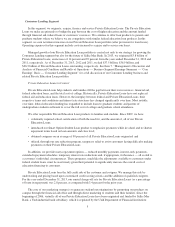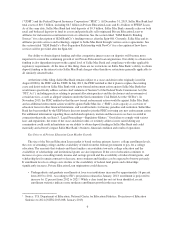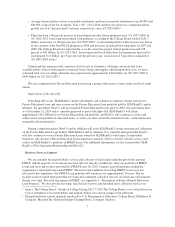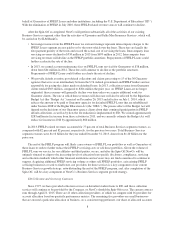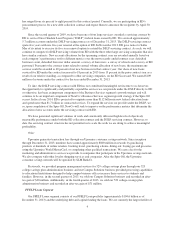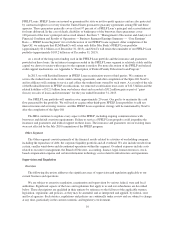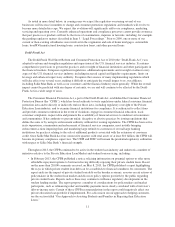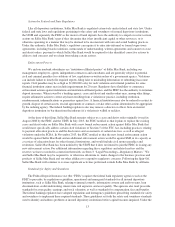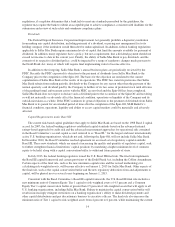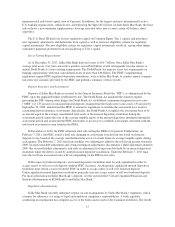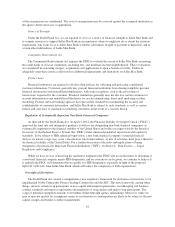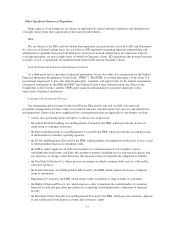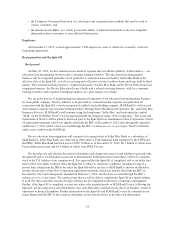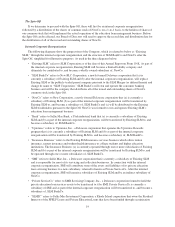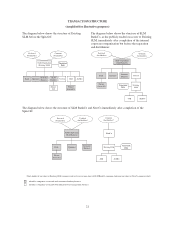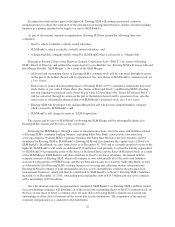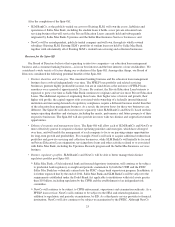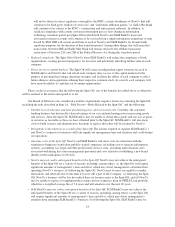Sallie Mae 2013 Annual Report Download - page 17
Download and view the complete annual report
Please find page 17 of the 2013 Sallie Mae annual report below. You can navigate through the pages in the report by either clicking on the pages listed below, or by using the keyword search tool below to find specific information within the annual report.minimum total risk-based capital ratio of 8 percent. In addition, for the largest and most internationally active
U.S. banking organizations, which do not, and following the Spin-Off will not, include Sallie Mae Bank, the final
rule includes a new minimum supplementary leverage ratio that takes into account certain off-balance sheet
exposures.
The U.S. Basel III final rule focuses regulatory capital on Common Equity Tier 1 capital, and introduces
new regulatory adjustments and deductions from capital as well as narrower eligibility criteria for regulatory
capital instruments. The new eligibility criteria for regulatory capital instruments results in, among other things,
cumulative perpetual preferred stock not qualifying as Tier 1 capital.
Stress Testing Requirements
As of December 31, 2013, Sallie Mae Bank had total assets of $10.7 billion. Once Sallie Mae Bank’s
average total assets over four consecutive quarters exceed $10 billion, it will subsequently become subject to
annual Dodd-Frank Act stress testing requirements. The Dodd-Frank Act imposes stress test requirements on
banking organizations with total consolidated assets of more than $10 billion. The FDIC’s implementing
regulations require FDIC-regulated depository institutions, such as Sallie Mae Bank, to conduct annual company-
run stress test scenarios provided by the FDIC and publish a summary of those results.
Deposit Insurance and Assessments
Deposits at Sallie Mae Bank are insured by the Deposit Insurance Fund (the “DIF”), as administered by the
FDIC, up to the applicable limits established by law. The Dodd-Frank Act amended the statutory regime
governing the DIF. Among other things, the Dodd-Frank Act established a minimum designated reserve ratio
(“DRR”) of 1.35 percent of estimated insured deposits, required that the fund reserve ratio reach 1.35 percent by
September 30, 2020, and directed the FDIC to amend its regulations to redefine the assessment base used for
calculating deposit insurance assessments. Specifically, the Dodd-Frank Act requires the assessment base to be
an amount equal to the average consolidated total assets of the insured depository institution during the
assessment period, minus the sum of the average tangible equity of the insured depository institution during the
assessment period and an amount the FDIC determines is necessary to establish assessments consistent with the
risk-based assessment system found in the FDIA.
In December of 2010, the FDIC adopted a final rule setting the DRR at 2.0 percent. Furthermore, on
February 7, 2011, the FDIC issued a final rule changing its assessment system from one based on domestic
deposits to one based on the average consolidated total assets of a bank minus its average tangible equity during
each quarter. The February 7, 2011 final rule modifies two adjustments added to the risk-based pricing system in
2009 (an unsecured debt adjustment and a brokered deposit adjustment), discontinues a third adjustment added in
2009 (the secured liability adjustment), and adds an adjustment for long-term debt held by an insured depository
institution where the debt is issued by another insured depository institution. Under the February 7, 2011 final
rule, the total base assessment rates will vary depending on the DIF reserve ratio.
With respect to brokered deposits, an insured depository institution must be well-capitalized in order to
accept, renew or roll over such deposits without FDIC clearance. An adequately capitalized insured depository
institution must obtain a waiver from the FDIC in order to accept, renew or roll over brokered deposits.
Undercapitalized insured depository institutions generally may not accept, renew or roll over brokered deposits.
For more information on Sallie Mae Bank’s deposits, see the section titled “Certain Unaudited Financial and
Statistical Information of SLM BankCo and Sallie Mae Bank.”
Regulatory Examinations
Sallie Mae Bank currently undergoes regular on-site examinations by Sallie Mae Bank’s regulators, which
examine for adherence to a range of legal and regulatory compliance responsibilities. A bank regulator
conducting an examination has complete access to the books and records of the examined institution. The results
15


